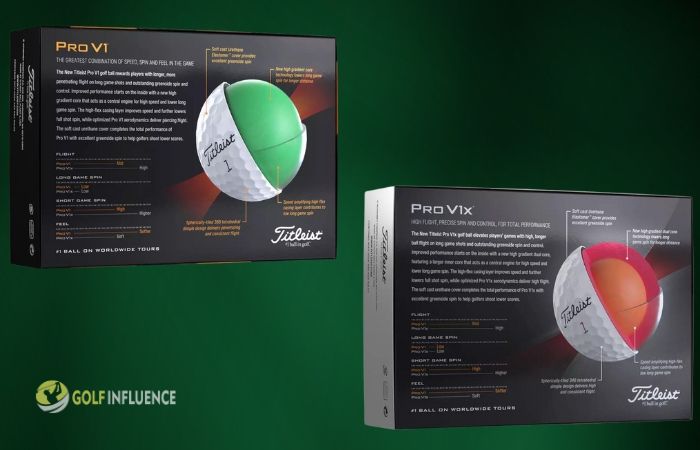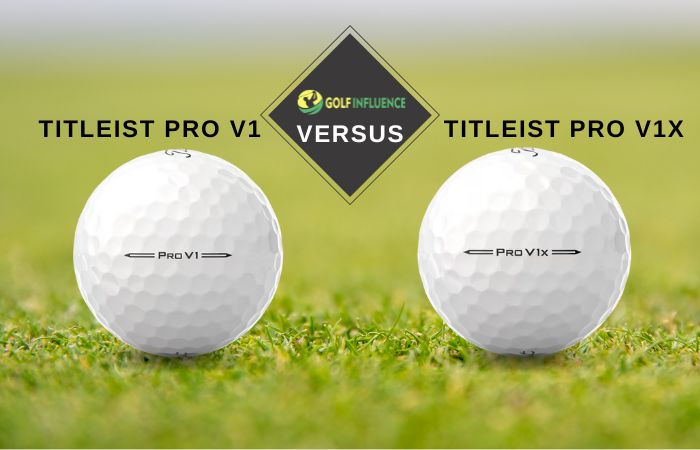Updated April 22, 2025. This article was thoroughly audited by multiple golf experts and coaches for its accuracy. You can read more about our rigorous testing protocol here.
The Titleist Pro V1 and Pro V1x golf balls deliver outstanding game play for golfers of all skill levels.
The two balls deliver penetrating ball flight and high short game spin, but each model provides specific benefits that players can utilize on the links.
Users of the Pro V’s among PGA Tour players include two-time major winner Justin Thomas, Jordan Spieth, and Adam Scott.
In our Titleist Pro V1 vs Pro V1x review, we’ll take a look at what makes each ball unique, which ball works best for your game, and why these two balls are a favorite among tour pros.
Titleist Pro V1 vs Pro V1x Review
Titleist Pro V1 Golf Balls
Best All Around Golf Ball

Check Price on Amazon
Check Price on PGA Tour Superstore
Check Price on Global Golf
Specifications
- Category: Distance
- Feel: Soft
- Launch: Mid-to-High
- Driver Spin: Low
- Wedge Spin: High
Pros
- Lower controllable mid-range flight
- Low driver spin equals more distance
- High greenside spin for shot-stopping power
Cons
- Relatively expensive golf ball for casual golfers
Comparing the Pro V1 and Pro V1x, the Pro V1 offers the most accessibility between the two premium golf balls, helping the largest number of casual players.
By producing lower rotation from the tee box and with longer irons, the Pro V1 increases accuracy for the players that need it the most.
While the Pro V1 and Pro V1x are both great golf balls, the V1 version flies farther, spins less, and maintains a tight dispersion, helping players hit more fairways to help increase their ability to post lower scores.
Around the greens, the regular V1 version also offers high rotation with a softer feel, increasing responsiveness.
Although the Pro V1 comes with a high price tag for a casual golfer, the benefits provided to the mid and high handicapper deliver outstanding value.
Titleist Pro V1x Golf Balls
Best High Spin Golf Ball

Check Price on Amazon
Check Price on PGA Tour Superstore
Check Price on Global Golf
Specifications
- Category: Distance
- Feel: Soft
- Launch: High
- Driver Spin: Low
- Wedge Spin: High
Pros
- Higher ball flight with more iron spin
- Firmer feel provides immediate feedback
- Penetrating ball flight provides a steep landing angle
Cons
- Better for precision players that don’t mind a higher spin rate
Between the Pro V1 and Pro V1x golf balls, the V1x model offers more control and precision, a perfect combination for advanced players and tour pros.
It also delivers some of the highest spin rates from a top-tier golf ball, making it a weapon for playing around the greens.
While some PGA Tour players dislike the increased rotation produced by the Pro V1x, most low-handicappers appreciate the control the V1x provides their game from the fairway and around the green.
Inexperienced players may find the V1x too erratic due to its high spin rates, but that is more an indictment of their skill set than the golf ball itself.
When choosing between the premium balls, Pro V1 and Pro V1x, the V1x is definitely designed to play to the strengths of the skilled golfer.
Titleist Pro V1 vs Pro V1x Comparison
| Titleist Pro V1 | Titleist Pro V1x |
| Longer distance compared to Pro V1x | Higher flight than Pro V1 |
| Better for mid and high handicappers | Better for low handicappers preferring workability |
| Lower flight and spin off the tee box compared to Pro V1x | Higher spin rate than Pro V1 |

Frequently Asked Questions
What is the main difference between Pro V1 and Pro V1x?
The primary difference between Pro V1 and Pro V1x lies in their flight and spin characteristics. The Pro V1 is designed for a penetrating, mid-trajectory flight with less spin, offering more roll.
Conversely, the Pro V1x launches higher and spins more, particularly on iron shots, allowing for greater stopping power and control around the greens.
Who should use a Titleist Pro V1x?
Golfers with higher swing speeds often benefit from the Pro V1x. The increased spin helps these players shape shots and hold greens.
It’s a popular choice among professionals and low handicappers who prioritize precision and control.
Is Pro V1 or Pro V1x better for slower swing speeds?
The Pro V1 generally suits golfers with slower swing speeds. Its lower spin helps maintain distance, as these players may struggle to compress the ball and generate optimal spin.
This can result in longer carry and roll.
Can high handicappers use Pro V1x?
Absolutely, high handicappers can use the Pro V1x. While its performance characteristics are geared towards skilled players, personal preference is key.
Some may prefer the feel and feedback, even if they don’t fully optimize its spin.
Should I use Pro V1 or Pro V1x?
For mid and high handicappers, the Pro V1 golf ball offers a very soft feel around the greens, plus the solid core produces high speed to help maintain distance from the tee box. The Pro V1 also provides more distance.
If you are a low handicapper who prefers higher spin with a slightly firmer feel, the Pro V1x remains the best ball to play with at your local golf club.
Our Verdict
For our money, the best golf ball on the market is the Titleist Pro V1. It offers the most accessibility to the largest group of players.
With a low penetrating trajectory and low long game spin, the Pro V1 will help weekend warriors find more control off the tee box and from the fairway.
If you are an experienced golfer who values workability, the Pro V1x golf balls deliver high spinny shots with much control.
The ball is as good as the Pro V1, but its slightly firmer feel and more penetrating ball flight works better for skilled players, especially when using short irons.
